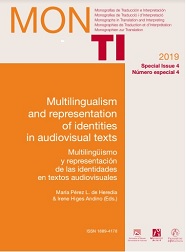The concept of quality in dubbing among translation students
Main Article Content
Abstract
Downloads
Article Details
The documents contained in these directories are included by the contributing authors as a means to ensure timely dissemination of scholarly and technical work on a non-commercial basis. It is understood that all persons copying this information will adhere to the terms and constraints invoked by each author's copyright. These works may not be reposted without the explicit permission of the copyright holder.
References
Abdallah, Kristiina. (2012) Translators in production networks. Reflections on agency, quality and ethics. Joensuu: Publications of the University of Eastern Finland.
Alfaro de Carvalho, Carolina. (2012) “Quality Standards or Censorship? Language Control Policies in Cable TV Subtitles in Brazil.” Meta 57:2, pp. 464–477.
Antonini, Rachel. (2005) “The perception of subtitled humor in Italy.” Humor 18:2, pp. 209-225.
Arumí, Marta; Jordi Carrabina; Anna Matamala; Bartolomé Mesa-Lao; Pilar Orero & Javier Serrano. (2013) “Audiovisual translation learning platform: a new tool for audiovisual translation training.” Hermeneus 15, pp. 39-66.
Bittner, Hansjörg. (2011) “The Quality of Translation in Subtitling.” Trans-kom 4:1, pp. 76-87.
Bourne, Julian & Christina Lachat. (2010) “Impacto de la norma AENOR: valoración del usuario.” En: Jiménez Hurtado, Catalina; Claudia Seibel & Ana Rodríguez Domínguez (eds.) 2010. Un corpus de cine: fundamentos teóricos y aplicados de la audiodescripción. Granada: Tragacanto, pp. 315-333.
Bucaria, Chiara & Delia Chiaro. (2007) “End-user perception of screen translation: the case of Italian dubbing.” TradTerm 13, pp. 91-118.
Casas Anguita, Juana; José Ramón Repullo & Juan de Mata Donado. (2003) “La encuesta como técnica de investigación. Elaboración de cuestionarios y tratamiento estadístico.” Atención primaria 31:8, pp. 527-538.
Chaume, Frederic. (2012) Audiovisual translation: dubbing. Manchester: St. Jerome.
Chaume, Frederic. (2007) “Quality standards in dubbing: a proposal.” TradTerm 13, pp. 71-89.
Chaume, Frederic. (2004) Cine y traducción. Madrid: Cátedra.
Conde Ruano, José Tomás. (2019) Dischronies and the absence of image in the evaluation of dubbing. En: Huertas Barros, Elsa; Sonia Vandepitte & Emilia Iglesias Fernández (eds.) 2019. Quality Assurance and Assessment Practices in Translation and Interpreting. Advances in Linguistics and Communication Studies Series. Hershey, PA: IGI Global, pp. 133-154.
De los Reyes, Julio. (2015) La traducción del cine para niños: un estudio sobre recepción. Castellón de la Plana: Universitat Jaume I. Tesis doctoral inédita.
Di Giovanni, Elena. (2012) “Why not ask the audience? An attempt to evaluate viewers” reception of subtitled films at festivals.” En: Dalziel, Fiona; Sara Gesuato & Maria Teresa Musacchio (eds.) 2012. A lifetime of English Studies. Essays in honour of Carol Taylor Torsello. Padua: Il Poligrafo, pp. 493-508.
Díaz Cintas, Jorge. (2003) Teoría y práctica de la subtitulación Inglés-Español. Barcelona: Ariel.
Fuentes-Luque, Adrián. (2005) “La recepción de la traducción audiovisual: humor y cultura.” En: Zabalbeascoa Terran, Patrick; Laura Santamaria Guinot & Frederic Chaume Varela (eds.) 2005. La traducción audiovisual: investigación, enseñanza y profesión. Granada: Comares, pp. 139-151.
Kiraly, Don. (2000) A Social Constructivist Approach to Translator Education. Empowerment from Theory to Practice. Manchester: St. Jerome.
Lång, Juha; Jukka Mäkisalo; Tersia Gowases & Sami Pietinen. (2013) “Using Eye Tracking to Study the Effect of Badly Synchronized Subtitles on the Gaze Paths of Television Viewers.” New Voices in Translation Studies 10, pp. 72-86.
Mayoral, Roberto. (2005) “Reflexiones sobre la investigación en traducción audiovisual.” En: Zabalbeascoa Terran, Patrick; Laura Santamaria Guinot & Frederic Chaume Varela (eds.) 2005. La traducción audiovisual: investigación, enseñanza y profesión. Granada: Comares, pp. 3-8.
Nord, Christiane; Masood Khoshsaligheh & Saeed Ameri. (2015) “Socio-Cultural and Technical Issues in Non-Expert Dubbing: A Case Study.” International Journal of Society, Culture & Language 3:2, pp. 1-16.
Ortiz-Boix, Carla & Anna Matamala. (2015) “Quality Assessment of Post-Edited versus Translated Wildlife Documentary Films: a Three-Level Approach.” En: O”Brien, Sharon & Michel Simard (eds.) 2015. Proceedings of 4th Workshop on Post-Editing Technology and Practice (WPTP4). Miami, pp. 16-30.
Segovia, Raquel. (2005) “Semiótica textual y traducción audiovisual.” En: Zabalbeascoa Terran, Patrick; Laura Santamaria Guinot & Frederic Chaume Varela (eds.) 2005. La traducción audiovisual: investigación, enseñanza y profesión. Granada: Comares, pp. 81-86.
Sokoli, Stavroula. (2005) “Temas de investigación en traducción audiovisual: la definición del texto audiovisual.” En: Zabalbeascoa Terran, Patrick; Laura Santamaria Guinot & Frederic Chaume Varela (eds.) 2005. La traducción audiovisual: investigación, enseñanza y profesión. Granada: Comares, pp. 177-185.
Zabalbeascoa, Patrick. (2008) “La credibilidad de los diálogos traducidos para audiovisuales.” En: Brumme, Jenny (ed.) 2008. La oralidad fingida: descripcióny traducción. Madrid: Iberoamericana, pp. 157-175.


